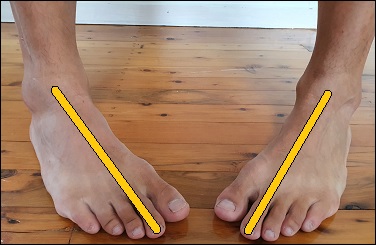Being pigeon-toed, also known as in-toeing, is a condition where an individual’s feet point inward when walking or standing. This condition is most commonly observed in children and often sparks concern among parents and caregivers. But is it truly detrimental to one’s health?
Before we address the potential concerns, it’s essential to understand the origins of in-toeing.
- Infant’s Foot Position: The position of a baby’s feet in the womb can sometimes result in the feet pointing inwards after birth. This is due to the limited space in the uterus, causing the feet to be pressed against each other.
- Tibial Torsion: This is a condition where the shinbone (tibia) twists inward. It’s the most common cause of in-toeing in toddlers and young children.
- Femoral Anteversion: This refers to an inward twist of the thigh bone (femur). It’s more common in older children and can cause the knees and feet to turn inward.
Natural Progression
One of the most reassuring aspects of in-toeing is its natural progression.
- Self-Correction: In many cases, as children grow, their bones gradually realign. By the time they reach adolescence, many outgrow the condition without any intervention.
- Growth Spurts: During growth spurts, children’s bones lengthen and often rotate. This can lead to temporary periods of increased in-toeing, which usually resolves on its own.
Potential Concerns
While in-toeing is often benign, there are some concerns associated with the condition.
- Tripping: Children with pronounced in-toeing might trip more frequently. This is because their feet can catch on each other as they walk or run.
- Physical Discomfort: In rare cases, in-toeing can cause discomfort or pain, especially after prolonged physical activity.
- Cosmetic Concerns: Some parents worry about the appearance of their child’s feet, fearing they might be teased or feel self-conscious.
When to Seek Medical Advice
Not every case of in-toeing requires medical intervention. However, there are specific scenarios where consulting a pediatric orthopedic specialist is advisable.
- Asymmetry: If one foot turns in significantly more than the other, it’s a good idea to seek a professional opinion.
- Lack of Improvement: If the condition doesn’t improve as the child grows or becomes more pronounced, it’s worth consulting a specialist.
- Pain or Discomfort: Any pain or discomfort associated with in-toeing should be evaluated by a medical professional.
Treatment Options
The majority of children with in-toeing do not require treatment. However, in cases where intervention is necessary, several options exist.
- Observation: Often, the best “treatment” is simply to wait and observe. As mentioned, many children outgrow the condition naturally.
- Physical Therapy: In some cases, physical therapy can help strengthen the muscles and improve foot alignment.
- Braces or Shoes: Special shoes or braces might be recommended in rare cases to help realign the foot. However, their efficacy is debated among professionals.
- Surgery: In very rare cases, if the in-toeing is severe and causing significant problems, surgery might be considered. This is typically a last-resort option.
The Psychological Aspect
Beyond the physical implications, it’s essential to consider the psychological impact of being pigeon-toed.
- Building Confidence: Parents and caregivers should ensure that children with in-toeing are not made to feel different or inferior. Building their confidence is crucial.
- Avoiding Teasing: It’s essential to address any teasing or bullying related to the condition. Educating peers and promoting understanding can help mitigate this.
FAQs
At what age is pigeon-toed most commonly noticed in children?
Pigeon-toed or in-toeing is often first noticed in infancy and early childhood. However, the exact age can vary depending on the underlying cause. For instance, metatarsus adductus (a curve in the foot) is noticed in infants, while tibial torsion is more common in toddlers, and femoral anteversion is often seen in children aged 5-10.
Are there specific exercises that can help correct in-toeing?
Yes, certain exercises can help strengthen the muscles and improve foot alignment, especially if the in-toeing is due to muscle imbalances. These exercises might include balance activities, foot and ankle stretches, and specific walking drills. However, it’s essential to consult with a physical therapist or pediatric orthopedic specialist to get tailored recommendations.
Is pigeon-toed hereditary?
There is some evidence to suggest that in-toeing can run in families. If a parent or sibling had the condition as a child, it might be more likely for the child to have it. However, environmental factors, such as the baby’s position in the womb, can also play a role.
Can wearing specific types of shoes as a child prevent or exacerbate in-toeing?
There’s a common misconception that wearing certain shoes can prevent or correct in-toeing. While supportive footwear is essential for overall foot health, no specific shoe type has been proven to correct in-toeing. Conversely, ill-fitting or overly restrictive shoes might exacerbate discomfort but won’t necessarily cause in-toeing.
Are there any long-term health implications for children who don’t outgrow being pigeon-toed?
Most children with in-toeing do not experience long-term health problems. However, if the condition persists into adulthood, some individuals might experience increased wear and tear on their joints, leading to discomfort or a higher risk of arthritis in the affected joints. It’s essential to monitor the condition and seek medical advice if concerns arise.
Is in-toeing more common in boys or girls?
In-toeing affects both boys and girls, but some studies suggest that femoral anteversion, one of the causes of in-toeing, might be slightly more common in girls. However, the overall prevalence of in-toeing does not show a significant gender bias.
Conclusion
Being pigeon-toed or in-toed is a common condition that many children experience. While it can cause some concerns, it’s essential to understand that most children outgrow it without any lasting effects. Parents and caregivers should monitor the condition, provide support, and seek medical advice if necessary. With the right understanding and approach, in-toeing can be managed effectively, ensuring that children lead healthy, active lives.
